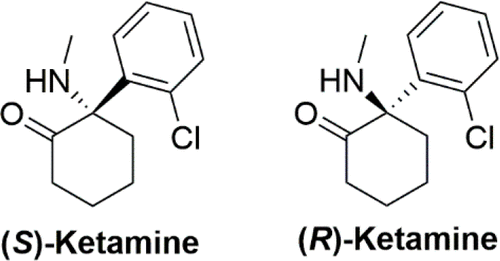当前位置:
X-MOL 学术
›
J. Med. Chem.
›
论文详情
Our official English website, www.x-mol.net, welcomes your
feedback! (Note: you will need to create a separate account there.)
Repurposing of Drugs-The Ketamine Story.
Journal of Medicinal Chemistry ( IF 6.8 ) Pub Date : 2020-09-11 , DOI: 10.1021/acs.jmedchem.0c01193 Joydip Das 1
Journal of Medicinal Chemistry ( IF 6.8 ) Pub Date : 2020-09-11 , DOI: 10.1021/acs.jmedchem.0c01193 Joydip Das 1
Affiliation

|
An intranasal formulation of esketamine, the S enantiomer of ketamine, in conjunction with an oral antidepressant, has been approved by the FDA for treating treatment-resistant major depressive disorder (TRD) in 2019, almost 50 years after it was approved as an intravenous anesthetic. In contrast to traditional antidepressants, ketamine shows a rapid (within 2 h) and sustained (∼7 days) antidepressant effect and has significant positive effects on antisuicidal ideation. Ketamine’s antidepressant mechanism is predominantly mediated by the N-methyl-d-aspartate receptor (NMDA) receptor, although NMDA-independent mechanisms are not ruled out. At the neurocircuitry level, ketamine affects the brain’s reward and mood circuitry located in the corticomesolimbic structures involving the hippocampus, nucleus accumbens, and prefrontal cortex. Repurposing of ketamine for treating TRD provided a new understanding of the pathophysiology of depression, a paradigm shift from monoamine to glutamatergic neurotransmission, thus making it a unique tool to investigate the brain and its complex neurocircuitries.
中文翻译:

毒品的用途-氯胺酮的故事。
氯胺酮的S对映异构体,氯胺酮的鼻内制剂与口服抗抑郁药一起,已于2019年被FDA批准用于治疗难治性重度抑郁症(TRD),距批准其为静脉麻醉药已近50年。与传统的抗抑郁药相比,氯胺酮显示出快速的抗抑郁作用(在2小时内)和持续的(约7天),并且对抗自杀观念具有显着的积极作用。氯胺酮的抗抑郁机制主要由N-甲基-d介导-天冬氨酸受体(NMDA)受体,尽管不排除NMDA非依赖性机制。在神经回路层面,氯胺酮会影响大脑皮质和边缘性皮质边缘结构(包括海马,伏隔核和前额叶皮层)中的奖励和情绪回路。氯胺酮用于治疗TRD的研究为抑郁症的病理生理学提供了新的认识,这是一种从单胺向谷氨酸能神经传递的转变,从而使其成为研究大脑及其复杂神经回路的独特工具。
更新日期:2020-09-11
中文翻译:

毒品的用途-氯胺酮的故事。
氯胺酮的S对映异构体,氯胺酮的鼻内制剂与口服抗抑郁药一起,已于2019年被FDA批准用于治疗难治性重度抑郁症(TRD),距批准其为静脉麻醉药已近50年。与传统的抗抑郁药相比,氯胺酮显示出快速的抗抑郁作用(在2小时内)和持续的(约7天),并且对抗自杀观念具有显着的积极作用。氯胺酮的抗抑郁机制主要由N-甲基-d介导-天冬氨酸受体(NMDA)受体,尽管不排除NMDA非依赖性机制。在神经回路层面,氯胺酮会影响大脑皮质和边缘性皮质边缘结构(包括海马,伏隔核和前额叶皮层)中的奖励和情绪回路。氯胺酮用于治疗TRD的研究为抑郁症的病理生理学提供了新的认识,这是一种从单胺向谷氨酸能神经传递的转变,从而使其成为研究大脑及其复杂神经回路的独特工具。











































 京公网安备 11010802027423号
京公网安备 11010802027423号